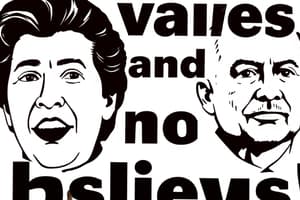Podcast
Questions and Answers
Match the action films with their main theme:
Match the action films with their main theme:
Die Hard = Problem-solving with force Lethal Weapon = Problem-solving with force Mad Max = Survival in a chaotic world John Wick = Revenge-driven narratives
Match the theorist with their theory:
Match the theorist with their theory:
Gramsci = Cultural hegemony Althusser = Film theory and class dynamics Destutt de Tracy = Origin of the term ideology Marx = Class struggle
Match the ideologies with their descriptions:
Match the ideologies with their descriptions:
Anarchism = Opposition to hierarchical authority Communism = Classless society and common ownership Feminism = Advocacy for women's rights Liberalism = Emphasis on individual liberties
Match the propaganda devices with their functions:
Match the propaganda devices with their functions:
Match the elements of lifestyle with their definitions:
Match the elements of lifestyle with their definitions:
Match the media theory with its significance:
Match the media theory with its significance:
Match the class dynamics with the associated theory:
Match the class dynamics with the associated theory:
Match the lifestyle elements with their types:
Match the lifestyle elements with their types:
Match the propaganda techniques with their descriptions:
Match the propaganda techniques with their descriptions:
Match the propaganda techniques with their examples:
Match the propaganda techniques with their examples:
Match the description with the correct propaganda technique:
Match the description with the correct propaganda technique:
Match the values with their descriptions:
Match the values with their descriptions:
Match the propaganda terms with their meanings:
Match the propaganda terms with their meanings:
Match the terms associated with propaganda to their definitions:
Match the terms associated with propaganda to their definitions:
Match the propaganda techniques with their characteristics:
Match the propaganda techniques with their characteristics:
Match the historical context of propaganda:
Match the historical context of propaganda:
Match the definitions of propaganda from Jowett and O'Denviell:
Match the definitions of propaganda from Jowett and O'Denviell:
Match the propaganda technique with its ultimate effect:
Match the propaganda technique with its ultimate effect:
Match the following phrases related to propaganda to their meanings:
Match the following phrases related to propaganda to their meanings:
Match the propaganda strategies with suitable scenarios:
Match the propaganda strategies with suitable scenarios:
Match the types of propaganda devices with their characteristics:
Match the types of propaganda devices with their characteristics:
Match the description of each technique with the correct name:
Match the description of each technique with the correct name:
Match the forms of influence with their purposes:
Match the forms of influence with their purposes:
Match the concept of values to their impacts:
Match the concept of values to their impacts:
Flashcards
Gramsci's Theory of Cultural Hegemony
Gramsci's Theory of Cultural Hegemony
A theory describing how the ruling class uses cultural institutions to maintain power and wealth in capitalist societies.
Althusserian Film Theory
Althusserian Film Theory
A framework analyzing how films portray class dynamics and ideologies that uphold social hierarchies.
Ideological Elements
Ideological Elements
Ideas, beliefs, understandings, and attitudes that shape our thinking and behavior.
Media Hegemony
Media Hegemony
Signup and view all the flashcards
Lifestyles
Lifestyles
Signup and view all the flashcards
Propaganda Devices
Propaganda Devices
Signup and view all the flashcards
Market Model
Market Model
Signup and view all the flashcards
Media and Ideology
Media and Ideology
Signup and view all the flashcards
What are values?
What are values?
Signup and view all the flashcards
What is propaganda?
What is propaganda?
Signup and view all the flashcards
What is public relations?
What is public relations?
Signup and view all the flashcards
What is spin?
What is spin?
Signup and view all the flashcards
What is news management?
What is news management?
Signup and view all the flashcards
What are propaganda devices?
What are propaganda devices?
Signup and view all the flashcards
What are the seven propaganda devices according to the IPA?
What are the seven propaganda devices according to the IPA?
Signup and view all the flashcards
What is the Institute for Propaganda Analysis (IPA)?
What is the Institute for Propaganda Analysis (IPA)?
Signup and view all the flashcards
Bandwagon
Bandwagon
Signup and view all the flashcards
Card Stacking
Card Stacking
Signup and view all the flashcards
Glittering Generalities
Glittering Generalities
Signup and view all the flashcards
Transfer
Transfer
Signup and view all the flashcards
Plain Folks
Plain Folks
Signup and view all the flashcards
Testimonial
Testimonial
Signup and view all the flashcards
Name Calling
Name Calling
Signup and view all the flashcards
Apparatus Theory of Media
Apparatus Theory of Media
Signup and view all the flashcards
Study Notes
Values and Attitudes
- Values are special kinds of beliefs that are hard to change.
- Attitudes are emotional responses to events and people.
- Values influence behavior.
- Attitudes are predispositions to react favorably or unfavorably to a situation, event, or person.
- Values act as criteria for judging ideas and practices.
- Values provide criteria for judgment.
- Spiritual values influence actions and decisions.
Propaganda
- Propaganda is the dissemination or promotion of particular ideas.
- Originally it meant "to propagate/sow".
- It's often used to advance religion or justify conquest throughout history.
- The Vatican established a congregation for propagating the faith in 1672.
- Propaganda was used to counter the spread of Protestantism in the past.
- The Institute for Propaganda Analysis (IPA) was created in 1937 to analyze propaganda used by Americans.
- Propaganda aims to change people's thoughts and actions.
- Propaganda is about communicating ideas to persuade people to think and behave a certain way.
Propaganda Devices
- Bandwagon: Everybody's doing it, so join in.
- Card Stacking: Presenting only positive aspects and hiding negative ones.
- Glittering Generalities: Using appealing words, but with no specific concrete details.
- Transfer: Using authority figure's image or words to promote a product or idea.
- Testimonial: Famous people endorse a product or idea.
- Plain Folks: Presenting a person as "one of the people."
- Name-calling: Using negative words to attack a person or idea.
Media and Ideology
- Ideology is the set of beliefs and values.
- Early use of the word "ideology" was coined by the French aristocrat and revolutionary, Antoine Destutt de Tracy (1754-1836).
- Derived from the Greek word -idea (Form/pattern) + logos (denoting discourse).
Media Organizations and Stakeholders
- Media organizations often use the principles of supply and demand (Market Model).
- The point of equilibrium (matching supply and demand) in a market model represents the optimum level.
Lifestyles
- Lifestyles are ways of living, including interests and behaviors.
- Lifestyles are influenced by social status, income, and attitudes.
- Mass advertising encourages people to prioritize products that match their desired lifestyle.
Studying That Suits You
Use AI to generate personalized quizzes and flashcards to suit your learning preferences.




